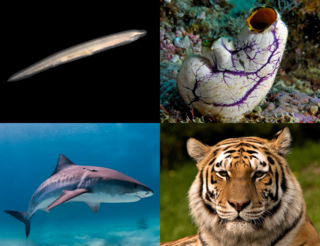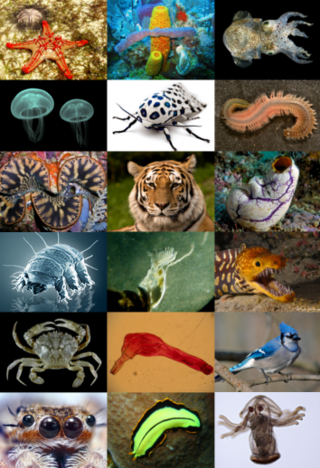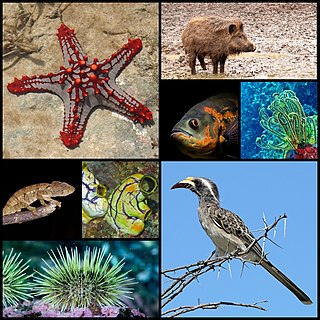Related Research Articles

A chordate is a deuterostomic animal belonging to the phylum Chordata. All chordates possess, at some point during their larval or adult stages, five distinctive physical characteristics (synapomorphies) that distinguish them from other taxa. These five synapomorphies are a notochord, a hollow dorsal nerve cord, an endostyle or thyroid, pharyngeal slits, and a post-anal tail. The name "chordate" comes from the first of these synapomorphies, the notochord, which plays a significant role in chordate body plan structuring and movements. Chordates are also bilaterally symmetric, have a coelom, possess a closed circulatory system, and exhibit metameric segmentation.
Developmental biology is the study of the process by which animals and plants grow and develop. Developmental biology also encompasses the biology of regeneration, asexual reproduction, metamorphosis, and the growth and differentiation of stem cells in the adult organism.

Embryo drawing is the illustration of embryos in their developmental sequence. In plants and animals, an embryo develops from a zygote, the single cell that results when an egg and sperm fuse during fertilization. In animals, the zygote divides repeatedly to form a ball of cells, which then forms a set of tissue layers that migrate and fold to form an early embryo. Images of embryos provide a means of comparing embryos of different ages, and species. To this day, embryo drawings are made in undergraduate developmental biology lessons.
The theory of recapitulation, also called the biogenetic law or embryological parallelism—often expressed using Ernst Haeckel's phrase "ontogeny recapitulates phylogeny"—is a historical hypothesis that the development of the embryo of an animal, from fertilization to gestation or hatching (ontogeny), goes through stages resembling or representing successive adult stages in the evolution of the animal's remote ancestors (phylogeny). It was formulated in the 1820s by Étienne Serres based on the work of Johann Friedrich Meckel, after whom it is also known as Meckel–Serres law.

Evolutionary developmental biology is a field of biological research that compares the developmental processes of different organisms to infer how developmental processes evolved.

A cephalochordate is an animal in the chordate subphylum Cephalochordata. Cephalochordates are commonly called lancelets, and possess 5 synapomorphies, or primary characteristics, that all chordates have at some point during their larval or adulthood stages. These 5 synapomorphies are a notochord, dorsal hollow nerve cord, endostyle, pharyngeal slits, and a post-anal tail. The fine structure of the cephalochordate notochord is best known for the Bahamas lancelet, Asymmetron lucayanum. Cephalochordates are represented in modern oceans by the Amphioxiformes and are commonly found in warm temperate and tropical seas worldwide. With the presence of a notochord, adult amphioxus are able to swim and tolerate the tides of coastal environments, but they are most likely to be found within the sediment of these communities.

The lancelets, also known as amphioxi, consist of some 30 to 35 species of "fish-like" benthic filter feeding chordates in the order Amphioxiformes. They are modern representatives of the subphylum Cephalochordata. Lancelets closely resemble 530-million-year-old Pikaia, fossils of which are known from the Burgess Shale. However, according to phylogenetic analysis, the lancelet group itself probably evolved around the Cretaceous, 97.7 million years ago for Pacific species and 112 million years ago for Atlantic species. Palaeobranchiostoma from the Permian may be part of the fossil record of lancelets; however, due to poor preservation, some doubt about its nature remains. Zoologists are interested in them because they provide evolutionary insight into the origins of vertebrates. Lancelets contain many organs and organ systems that are closely related to those of modern fish, but in a more primitive form. Therefore, they provide a number of examples of possible evolutionary exaptation. For example, the gill-slits of lancelets are used for feeding only, and not for respiration. The circulatory system carries food throughout their body, but does not have red blood cells or hemoglobin for transporting oxygen. Lancelet genomes hold clues about the early evolution of vertebrates: by comparing genes from lancelets with the same genes in vertebrates, changes in gene expression, function and number as vertebrates evolved can be discovered. The genome of a few species in the genus Branchiostoma have been sequenced: B. floridae,B. belcheri, and B. lanceolatum.
Plant embryonic development, also plant embryogenesis is a process that occurs after the fertilization of an ovule to produce a fully developed plant embryo. This is a pertinent stage in the plant life cycle that is followed by dormancy and germination. The zygote produced after fertilization must undergo various cellular divisions and differentiations to become a mature embryo. An end stage embryo has five major components including the shoot apical meristem, hypocotyl, root meristem, root cap, and cotyledons. Unlike the embryonic development in animals, and specifically in humans, plant embryonic development results in an immature form of the plant, lacking most structures like leaves, stems, and reproductive structures. However, both plants and animals including humans, pass through a phylotypic stage that evolved independently and that causes a developmental constraint limiting morphological diversification.

In developmental biology, animal embryonic development, also known as animal embryogenesis, is the developmental stage of an animal embryo. Embryonic development starts with the fertilization of an egg cell (ovum) by a sperm cell, (spermatozoon). Once fertilized, the ovum becomes a single diploid cell known as a zygote. The zygote undergoes mitotic divisions with no significant growth and cellular differentiation, leading to development of a multicellular embryo after passing through an organizational checkpoint during mid-embryogenesis. In mammals, the term refers chiefly to the early stages of prenatal development, whereas the terms fetus and fetal development describe later stages.

Pharyngeal slits are filter-feeding organs found among deuterostomes. Pharyngeal slits are repeated openings that appear along the pharynx caudal to the mouth. With this position, they allow for the movement of water in the mouth and out the pharyngeal slits. It is postulated that this is how pharyngeal slits first assisted in filter-feeding, and later, with the addition of gills along their walls, aided in respiration of aquatic chordates. These repeated segments are controlled by similar developmental mechanisms. Some hemichordate species can have as many as 200 gill slits. Pharyngeal clefts resembling gill slits are transiently present during the embryonic stages of tetrapod development. The presence of pharyngeal arches and clefts in the neck of the developing human embryo famously led Ernst Haeckel to postulate that "ontogeny recapitulates phylogeny"; this hypothesis, while false, contains elements of truth, as explored by Stephen Jay Gould in Ontogeny and Phylogeny. However, it is now accepted that it is the vertebrate pharyngeal pouches and not the neck slits that are homologous to the pharyngeal slits of invertebrate chordates. Pharyngeal arches, pouches, and clefts are, at some stage of life, found in all chordates. One theory of their origin is the fusion of nephridia which opened both on the outside and the gut, creating openings between the gut and the environment.

The pharyngeal arches, also known as visceral arches, are structures seen in the embryonic development of vertebrates that are recognisable precursors for many structures. In fish, the arches are known as the branchial arches, or gill arches.

A body plan, Bauplan, or ground plan is a set of morphological features common to many members of a phylum of animals. The vertebrates share one body plan, while invertebrates have many.
Genomic phylostratigraphy is a novel genetic statistical method developed in order to date the origin of specific genes by looking at its homologs across species. It was first developed by Ruđer Bošković Institute in Zagreb, Croatia. The system links genes to their founder gene, allowing us to then determine their age. This could help us better understand many evolutionary processes such as patterns of gene birth throughout evolution, or the relationship between the age of a transcriptome throughout embryonic development. Bioinformatic tools like GenEra have been developed to calculate relative gene ages based on genomic phylostratigraphy.
Important structures in plant development are buds, shoots, roots, leaves, and flowers; plants produce these tissues and structures throughout their life from meristems located at the tips of organs, or between mature tissues. Thus, a living plant always has embryonic tissues. By contrast, an animal embryo will very early produce all of the body parts that it will ever have in its life. When the animal is born, it has all its body parts and from that point will only grow larger and more mature. However, both plants and animals pass through a phylotypic stage that evolved independently and that causes a developmental constraint limiting morphological diversification.

Plant evolution is the subset of evolutionary phenomena that concern plants. Evolutionary phenomena are characteristics of populations that are described by averages, medians, distributions, and other statistical methods. This distinguishes plant evolution from plant development, a branch of developmental biology which concerns the changes that individuals go through in their lives. The study of plant evolution attempts to explain how the present diversity of plants arose over geologic time. It includes the study of genetic change and the consequent variation that often results in speciation, one of the most important types of radiation into taxonomic groups called clades. A description of radiation is called a phylogeny and is often represented by type of diagram called a phylogenetic tree.

Deuterostomes are bilaterian animals of the superphylum Deuterostomia, typically characterized by their anus forming before the mouth during embryonic development. The three major clades of extant deuterostomes include chordates, echinoderms and hemichordates.

Parhyale hawaiensis is an amphipod crustacean species that is used in developmental and genetic analyses. It is categorized as an emerging model organism as the main biological techniques necessary for the study of an organism have been established.

In developmental biology, von Baer's laws of embryology are four rules proposed by Karl Ernst von Baer to explain the observed pattern of embryonic development in different species.
In Embryology a phylotypic stage or phylotypic period is a particular developmental stage or developmental period during mid-embryogenesis where embryos of related species within a phylum express the highest degree of morphological and molecular resemblance. Recent molecular studies in various plant and animal species were able to quantify the expression of genes covering crucial stages of embryo development and found that during the morphologically defined phylotypic period the evolutionary oldest genes, genes with similar temporal expression patterns, and genes under strongest purifying selection are most active throughout the phylotypic period.

Eileen E. M. Furlong is an Irish molecular biologist working in the fields of transcription, chromatin biology, developmental biology and genomics. She is known for her work in understanding how the genome is regulated, in particular to how developmental enhancers function, how they interact within three dimensional chromatin topologies and how they drive cell fate decisions during embryogenesis. She is Head of the Department of Genome Biology at the European Molecular Biology Laboratory (EMBL). Furlong was elected a member of the European Molecular Biology Organization (EMBO) in 2013, the Academia Europaea in 2016 and to EMBO’s research council in 2018.
References
- ↑ Gilbert SF (2000). Developmental mechanisms of evolutionary change. in: Developmental Biology (6th ed.). Sinauer Associates. ISBN 0-87893-243-7.
- ↑ Ballard WW (1981). "Morphogenetic Movements and Fate Maps of Vertebrates". American Zoologist. 21 (2): 391–9. doi:10.1093/icb/21.2.391.
- ↑ Sprague, J.; et al. (2006). "ZFIN Pharyngula Period Description". Zebrafish Information Network. Retrieved 2007-07-18.
- ↑ Haeckel E (1874) Anthropogenie oder Entwickelungsgeschichte des Menschen. Engelmann, Leipzig
- ↑ Duboule D. 1994. Temporal colinearity and the phylotypic progression: a basis for the stability of a vertebrate Bauplan and the evolution of morphologies through heterochrony. Dev Suppl:135–142.
- ↑ Prud'homme B, Gompel N (2010). "Evolutionary biology: Genomic hourglass". Nature. 468 (7325): 768–9. Bibcode:2010Natur.468..768P. doi: 10.1038/468768a . PMID 21150985. S2CID 205060817.
- ↑ Irie N, Sehara-Fujisawa A (2007). "The vertebrate phylotypic stage and an early bilaterian-related stage in mouse embryogenesis defined by genomic information". BMC Biology. 5: 1. doi: 10.1186/1741-7007-5-1 . PMC 1797197 . PMID 17222327.
- ↑ Kalinka AT, Varga KM, Gerrard DT, Preibisch S, Corcoran DL, Jarrells J, Ohler U, Bergman CM, Tomancak P (2010). "Gene expression divergence recapitulates the developmental hourglass model". Nature. 468 (7325): 811–4. Bibcode:2010Natur.468..811K. doi:10.1038/nature09634. PMID 21150996. S2CID 4416340.
- ↑ Domazet-Lošo T, Tautz D (2010). "A phylogenetically based transcriptome age index mirrors ontogenetic divergence patterns". Nature. 468 (7325): 815–8. Bibcode:2010Natur.468..815D. doi:10.1038/nature09632. PMID 21150997. S2CID 1417664.
- ↑ Irie N, Kuratani S (2011). "Comparative transcriptome analysis reveals vertebrate phylotypic period during organogenesis". Nature Communications. 2 (248): 248. Bibcode:2011NatCo...2..248I. doi:10.1038/ncomms1248. PMC 3109953 . PMID 21427719.